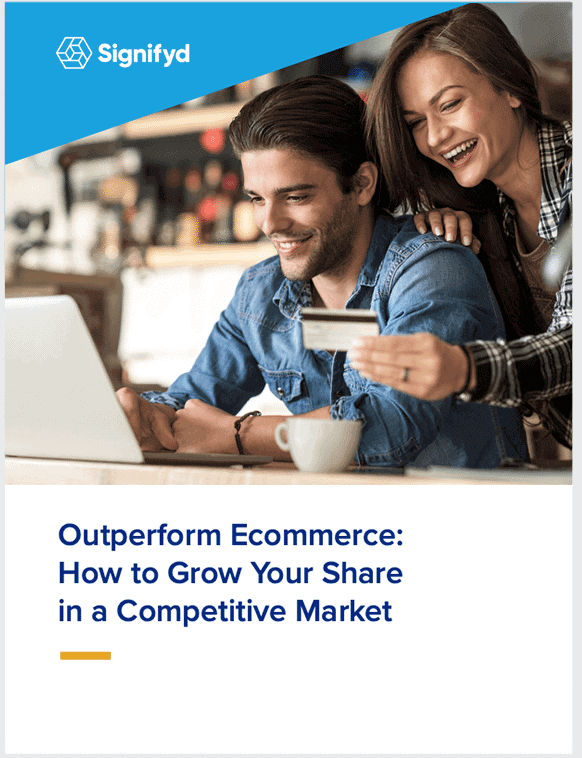Ecommerce retailers have heard this one a thousand times—you have to create a customer-first shopping experience to stay competitive in the market. They’ve also heard another thing a thousand times when asking how to implement the necessary tactics to create the right customer experience: silence.
Our latest ebook—Outperform Ecommerce: How to Grow Your Share in a Competitive Market—was created with the “how?” question in mind. The ebook provides answers to key issues for ecommerce retailers, with practical solutions and data-driven explanations on why customer experience is a crucial part of your online retail success.
Start building your new customer experience model with these three ideas for improving your website processes.

Download the Outperform Ecommerce Ebook
Remove barriers from the buying process
Problem: Shoppers are easily turned off by overly complicated checkout experiences.
Retailers protect themselves by requiring consumers to create accounts or log in to established social media accounts before ordering online. It’s a common tactic to minimize fraud risk. It’s also a major snag in an otherwise seamless buying process. Signifyd’s consumer experience survey, conducted by Survata, found that 37.6 percent of consumers found needing to create an account or login annoying or very annoying.
Solution: Create a “guest” checkout method with no account needed and only the minimum amount of data required.
Set up that page to accept as many online payment options as possible. Or take a cue from Amazon’s one-click purchasing. Never fear: Amazon’s patent on the technology they pioneered has expired. A better checkout experience is only a click away for your customers.
Personalize the customer experience
Problem: Personalization technology is so hot right now that everyone’s doing it—with poor implementation.
Customers assume their own risk by sharing their data to get the item they really want. In turn, customers expect more in return for their data. Over 60 percent of consumers surveyed by Accenture are interested in personalized recommendations from the ecommerce stores they shop, and most of them are willing to share their data in exchange for benefits like coupons, loyalty points, exclusive deals, rewards and personalized special offers.
It’s clear that personalization is important to consumers, but only 12 percent of marketers are “very” or “extremely” satisfied with their personalization marketing efforts, while 38 percent are only “moderately” satisfied, according to Evergage Inc.’s “2018 Trends in Personalization.”
Solution: Streamline your data.
A common issue in personalization implementation is a lack of a reliable data collection system. On average, ecommerce retailers store customer data in four different systems, according to Evergage. More than half don’t feel they can mine their data for insights that will let them do effective personalization. We recognize that it takes time and money to hire data experts, but the rewards outweigh the financial burden to take on such a project.
Don’t treat your customers like criminals when it comes to fraud management
Problem: Fear of fraud causes merchants to erect barriers that dramatically degrade their customers’ buying experience.
As retailers scramble to curb fraud, they risk damaging their customer relationships. In a Signifyd survey of 2,000 consumers, conducted by Survata, 65.5 percent said they would not shop with an online retailer again if that retailer declined an order for no apparent reason — a typical false-decline scenario. False declines, or withholding legitimate orders for fear of fraud, costs retailers more than what they spend on trying to prevent fraud, according to a widely cited Business Insider study.
Solution: Use a new model of fraud management called guaranteed fraud protection.
The model combines big data, machine learning, and a financial liability shift to transfer the burden of fraud from the merchant to the enterprise fraud protection provider. The guaranteed model’s learning machines are able to sift legitimate orders from fraudulent ones in milliseconds. Retailers can automate their orders with confidence that outgoing orders have been approved. If the model approves an order that later turns out to be fraudulent, the merchant is reimbursed for all the costs created by the fraudulent order.
Cybersource, in its 2017 Online Fraud Benchmark report, found that 75 percent of online businesses relied on manual review for making decisions on an average of 25 percent of their orders. A high volume of manual reviews accounts for most of the affected companies’ fraud-management budgets—with a direct impact on profit margins. The real advantage to guaranteed fraud protection is its ability to drive new revenue. The machine learning adds precision to the review process and the guarantee means that retailers can ship more orders without worrying that the orders might be fraudulent.
Pathways to success
An increased focus on improving the customer experience and perhaps an additional investment in your ecommerce website provides a competitive advantage over other retailers who struggle to keep up with their customers’ needs and wants. Outperform Ecommerce: How to Grow Your Share in a Competitive Market contains more solutions to help boost your customer experience, plus data that supports why all this is key in the first place—in case you need to convince other stakeholders in your company that it’s time to make changes in your strategy.
Download the ebook now and get started with tips to help your business make sales and keep up in a crowded market.
Photo by iStock







